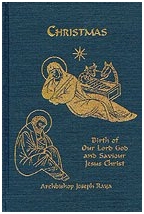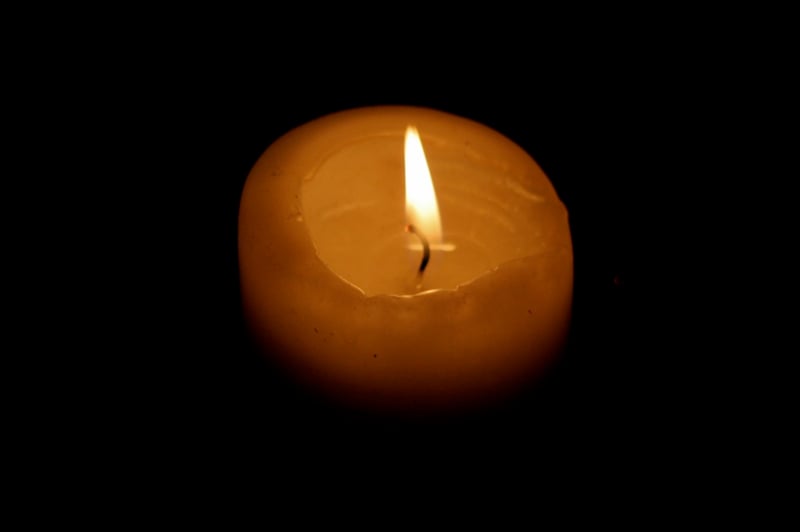I am proud to dwell in an “East-West” home, being Roman Catholic while my husband is a deacon in the Eastern Catholic Church (specifically Melkite). The Melkite Church worships in the Byzantine tradition.
 As a result we have a most interesting home library. One book, Christmas: Birth of our Lord God and Saviour Jesus Christ by Archbishop Joseph Raya, caught my attention. Archbishop Raya, a once-prominent Melkite bishop, was born in Zahlé, Lebanon and was privileged to serve in Galilee and in particular, Nazareth.
As a result we have a most interesting home library. One book, Christmas: Birth of our Lord God and Saviour Jesus Christ by Archbishop Joseph Raya, caught my attention. Archbishop Raya, a once-prominent Melkite bishop, was born in Zahlé, Lebanon and was privileged to serve in Galilee and in particular, Nazareth.
In his book Archbishop Raya writes of kenosis, an emptying of God in order to become human. St. Paul describes our Lord in Philippians 2:6-7 as one
“who, existing in the form of God, counted not the being on an equality with God a thing to be grasped, but emptied himself, taking the form of a servant, being made in the likeness of men.”
 Mandie, Empty,
Flickr Creative Commons
Mandie, Empty,
Flickr Creative Commons
The Archbishop demonstrated how Jesus practiced this emptying:
“Kenosis was for our Lord Jesus Christ such a sublime and sincere attitude that He forbade His apostles to talk about what everybody called “miracles,” since for Him these were simple acts of love in favour of the poor and the needy. He called Himself, in the Gospel of Mark, ‘Son of Man.’ He corrected the young man who called Him ‘good Master’ by telling him, ‘There is no good but God Himself.’ (Mk 10:18).”
Jesus meant to identify himself with us.
[Tweet "Jesus meant to identify himself with us. Meditations on #kenosis by @susanbailey"]
In considering Christ’s birth at Christmas, Eastern thought often refers to the “condescension” of God. Archbishop Raya cites Saint John Chrysostom:
“The condescension of God is when God does not appear as He really is, but according to the capacity of the one who seeks to contemplate Him.”
Thus we, limited as we are in our fallible humanity, are now able to ponder the One who is beyond our comprehension because He came to us as a man.
Christ’s birth at Christmas is a mystery, something to ponder without necessarily trying to solve it. Just the mere thought of such a mystery is a pleasing form of prayer to God.
So I think of God in the form of Jesus Christ, freely emptying himself of any privilege due him because he is God, coming down to meet with us in the most vulnerable of forms – a newborn child. What must it have been like for him to do that? Think on that a bit.
 Joerg Moellenkamp, Advent,
Flickr Creative Commons
Joerg Moellenkamp, Advent,
Flickr Creative Commons
It leads to the obvious question of emptying myself: How would it feel for me do that in imitation of Christ? Could I do it? What can I do to renounce claims to what I think is due to me in order to love others? What do I cling to and how can I let it go?
St. Thérèse of Lisieux is good to turn in this case: she would counsel starting small. Think first of what you treasure, and then think of small ways of divesting yourself. I think about what I most treasure -- free time – and how I chafe whenever I am asked to give it up. Perhaps if I take some time to gaze upon the manger scene and contemplate what Jesus gave up, I can then ask for the grace to let go of this and others of my treasures.
When I meditate on what Jesus gave up, it seems the least that I can do. Archbishop Raya writes:
“The story of His passion is in every single detail a stunning story of one who is above and beyond human humiliations and blows and even killing. Through the unfolding of this whole amazing event He did not complain, or hurt by any word those who scourged Him, insulted Him and made a mockery of Him. Even after His triumph and resurrection He did not stoop down from His majesty to show them how wrong they were. This attitude of kenosis was one of the most glorious characteristics of the love of our Lord for our humanity and of His identification with us, His respect of our freedom. Thus God the Son emptied Himself at His very incarnation and birth from all the appearances of glory and the majesty of His divinity in order to appear in the human form which we know and are familiar with.”
By emptying ourselves, we make room for God’s Spirit. In the giving of ourselves, we receive the greatest gift of all. It’s time to gaze upon the manger and take those first small steps. I will ask St. Thérèse to accompany me.
You can purchase a copy of “Christmas: Birth of Our Lord God and Saviour Jesus Christ in His Private Life” through Madonna House Publications at publications.madonnahouse.com/products/christmas
Copyright 2016 Susan W. Bailey.
This post originally appeared in the December 9, 2016 edition of The Catholic Free Press. Reprinted with permission.
About the Author

Susan Bailey
Susan Bailey is the author of River of Grace: Creative Passages Through Difficult Times (Ave Maria Press), and Louisa May Alcott: Illuminated by The Message (ACTA Publications), part of their Literary Portals to Prayer series. Along with her blogs Be as One and Louisa May Alcott is My Passion, Susan writes for the Diocese of Worcester newspaper, The Catholic Free Press.


.png?width=1806&height=731&name=CatholicMom_hcfm_logo1_pos_871c_2728c%20(002).png)
Comments